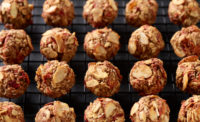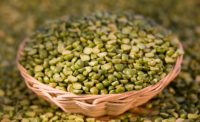U.S. consumers are increasingly more health-conscious and looking for ways to incorporate better-for-you foods into their diets, even when they’re snacking. Consequently, a manufacturer’s ability to deliver a healthier snack or baked good is more important than ever. As counterintuitive as it may seem, drizzles and coatings offer manufacturers opportunities to provide some of the health benefits consumers seek in foods.
Even when it comes to better-for-you foods, consumers aren’t willing to trade off on taste. And that’s where drizzles and coatings come in, bakers and snack manufacturers are discovering. By adding a functional chocolate drizzle or coating to a nutrition bar or snack, for instance, they can elevate both the product’s nutritional profile and taste.
“One of the biggest innovations in the compound space is the development of functional compounds,” says Stacy Reed, product development manager, Cargill Cocoa & Chocolate North America, Milwaukee. Functional compounds enable formulators to add vitamins, minerals and protein to products.
Thomas Jablonowski, senior technical service manager, Cargill Cocoa & Chocolate, adds that since formulators now can add more protein to coatings and drizzles, they can create coatings that increase the health profile of the total finished snack or baked good. He notes that beyond protein, Cargill offers coatings that deliver other types of consumer-desired benefits, such as natural flavor, reduced sodium and simple ingredients.
Building a better bar
Millennials are driving much of the health-focused demand in snacking, buying an estimated 29 percent of all consumer packaged goods by 2020, notes Jessica Blondeel, product manager, SBU Chocolate, Puratos, Cherry Hill, NJ. They are also big snackers, she says, and eat snacks for breakfast, lunch and dinner. And they are twice as likely to snack as other generations, and use snacks to replace traditional meals, she adds.
Creating a baked good or snack for these consumers with a profile that boasts a health claim of being a “good” or “excellent” source of protein can pose some technical challenges for manufacturers. “Adding protein to the base of a bar can create flavor issues that can make bars unpalatable,” says Reed. “One solution is to the add protein to the compound coating by boosting the amount of milk, casein or whey proteins. Adding dairy protein to compound coatings tends to increase viscosity. Developers may need to add fat to thin the coating back to its original consistency.
“However, today’s savvy consumers are wary of extra fat and calories,” Reed continues. “Cargill has found that using larger particle sizes in coatings is one key to solving this issue. Larger coating particles bind less fat than finer particles because they allow more free fat to circulate in the coating without increasing overall fat content. Larger particles also help maintain coating viscosity, so it is suitable for enrobing or adding to the bottoms of snack bars.”
When it comes to addressing possible off-flavors in a protein-enhanced snack bar, manufacturers may find the solution working with a flavor company. Paula LaBine, senior manager, snack end-use market (EUM), Kerry Ingredients, St. Louis, points out that the company has a “dedicated R&D group focused on bar formulation and compound coatings that collaborates with in-house applications experts in flavors and flavor-masking technology.” This enable the company to help formulators create a bar formula that delivers on nutrition and great taste.
Less is more
Today’s health-conscious consumers want protein and other nutritional ingredients in their baked goods and snacks, but there are also many things they don’t want. “Sugar is a key concern for snack bar consumers,” says LaBine. “Forty percent of consumers cite they look for bars with low/no/reduced sugar claims.” Using reduced-sugar compound coatings is one way to help meet this demand.
A high level of fat is also often unwelcome. Puratos offers compound coatings that contain zero grams of trans fat, says Blondeel. “Our zero-gram trans fat compounds are receiving a lot of attention in the confectionary market,” she notes. “We offer both hard compound coatings and soft decoration creams in different flavors. Since compound coatings only contain vegetable fats, they do not need to be tempered. Customers do not have to invest in high-skilled labor or expensive equipment.
“Our decoration creams go one step further and set up at room temperature, eliminating the need for coolers or freezers,” Blondeel continues. “Customers can finish their cakes and cookies with a shiny compound coating that has a clean cut and is touch dry, making it easier to package.”
For consumers seeking transparency and sustainability in the foods they eat, LaBine suggests sustainable compound coatings that meet qualifications such as organic, Non-GMO Project Verified, rBST free and Rainforest Alliance certified.
Blondeel agrees that consumers are increasingly concerned about product sourcing. “A trend we see is that more consumers are curious about where their food comes from,” she says. “Apart from a great-tasting product, consumers want to be able to trace ingredients back to the earth, to the conditions in which these ingredients were grown and to the people who farmed them.”
Because chocolate remains the No. 1 flavor when it comes to coatings, Blondeel says Puratos transitioned its entire Carat compound range on Jan. 1 to use 100 percent sustainable cocoa powder. “Carat is now sourced from our Cacao-Trace program, which is a unique program with certification,” she explains.
The program features two cocoa collection centers—one in the Ivory Coast and one in Vietnam. “Our holistic approach aims to generate better profitability and better product by focusing on the professionalism of the farmers and also the processing,” Blondeel says. “Through education on agricultural and environmental practices, we can help farmers generate increased crop volume and higher incomes while protecting the environment. Puratos controls the fermentation and drying process, thus guaranteeing a consistent and high-quality end product. This allows us to fulfill consumers’ desire for more-transparent sourcing and raise the bar on great tasting products.”
The newest generation of drizzles and coatings bring more to snack and bakery products than visual interest. The right drizzle or compound coating can boost protein content or vitamins, help achieve a sustainability claim or even reduce a manufacturer’s energy consumption. Look for these products to continue bringing exciting innovations to bakers and snack makers and keep nutritionally enhanced products on top of consumers’ must-buy list.







